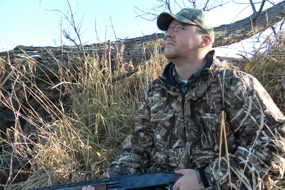Big Game Logic is reader-supported. When you buy through links on our site, we may earn an affiliate commission.
It was one of those mornings you can envision ducks falling from the sky. The old ten horse motor sputtered into a secluded backwater off the Chippewa River in Northern Wisconsin. Dense snow clouds prevented the stars from peeking through.
The backwater is known as Five Fingers and for good reason. There are five fingers of solid ground protruding from the main peninsula that creates this bay. The fingers are all about 15 feet wide and reach out at varying distances. I don’t live in the area anymore and haven’t hunted it for five or six years. But memories of several legendary mornings I witnessed there will remain with me forever.

There is one scene from this particular day that remains etched in my mind. The day was colder than most and the snow was flying. A small flock of mallards peeled off the main channel of the river and right into our spread. This setup was perfect for a north wind. As birds moved up the river from the south they had an open look at the decoys.
The shoreline ran east to west so your back was always to the north. These unsuspecting mallards set their wings and dropped right into the decoys. As the lead bird put his feet down, we let them have it. When the action was over, three greenheads were motionless. Tufts of down littered the surface of the water.
It was a great shoot but it could have been better had my gun not jammed after the first shot. I carry a small tool kit in my blind bag but we just couldn’t free the shell from the chamber. Days like this are too precious to waste so we decided against heading in. Jason, my hunting partner graciously offered to alternate shooting with his gun. Shortly afterward, another small group of mallards investigated the spread and another greenhead was added to the game strap.
It was now my turn to handle the gun. Jason would take over the calling duties and supervise my shooting. About an hour later, I would have my chance. A trio of ducks running down the river from the north hooked around the point and came our way. They didn’t circle. Just a straight flight path followed up with locked wings as if they were passenger jets approaching an airport.
I picked out the lead drake and dropped him. Then… I just watched. Flying with these two mallard drakes was the only pintail I have ever seen in Northern Wisconsin. It wasn’t just any pintail, it was a gorgeous bull sprig. A magazine cover sprig. A wall mounting sprig. But pintail season closed in Wisconsin weeks earlier. The only thing I could do was watch.
There are duck hunters in some states that find pintails as ordinary as apple pie. A friend of mine who hunts in California, shoots one nearly every day he is in the blind. But I look forward to the day I see another pintail like that one. His silhouette against the snowy bluffs of the Chippewa River stand out in my mind. The rust and grey plumage blended into the scene, yet he stood out from the surroundings.
Someday I’d like to put a bird like that on the wall. When I get another chance, I plan to make it count. A good friend of mine is a taxidermist and I asked him for some tips on preserving a trophy duck for the wall. Here’s what he recommends:
- Late Season Birds: Pin feathers are fully developed and ducks are dressed in their Sunday best as they prepare for mating.
- Hound Control: If Ol’ Red is overzealous in his handling of birds, keep him on shore and retrieve the duck yourself if you think it might be a trophy.
- Care & Cleaning: Wipe any visible blood off the bird and smooth out the feathers. Handle the bird by it’s feet and don’t put it in a game strap.
- Storage: Lay the head under the wing and place the bird directly into a freezer bag. Push all the air out of the bag and seal it. The sooner you can get the bird to the taxidermist, the better. If you are on the road, freezing is acceptable. However, don’t allow the bird to freezer burn by leaving it in your freezer for several months.
Ducks don’t have big antlers or long beards. A duck’s trophy potential is often the circumstances which surrounded the moment of harvest. With proper care, that moment can be preserved and shared with others on the wall of your living room, den, or office.
